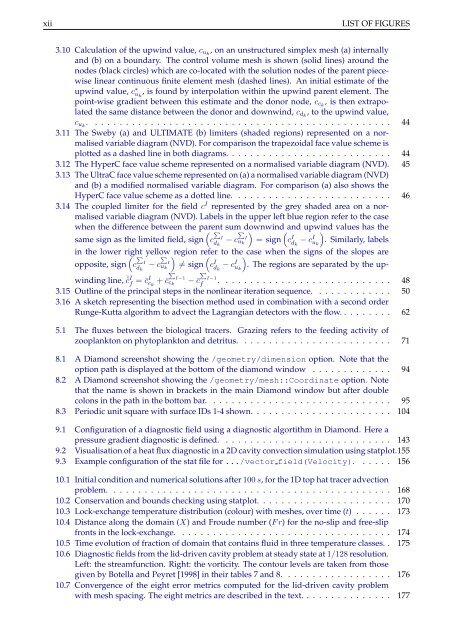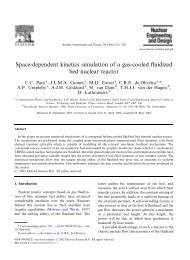Chapter 8 Configuring Fluidity - The Applied Modelling and ...
Chapter 8 Configuring Fluidity - The Applied Modelling and ...
Chapter 8 Configuring Fluidity - The Applied Modelling and ...
Create successful ePaper yourself
Turn your PDF publications into a flip-book with our unique Google optimized e-Paper software.
xii LIST OF FIGURES<br />
3.10 Calculation of the upwind value, cuk , on an unstructured simplex mesh (a) internally<br />
<strong>and</strong> (b) on a boundary. <strong>The</strong> control volume mesh is shown (solid lines) around the<br />
nodes (black circles) which are co-located with the solution nodes of the parent piecewise<br />
linear continuous finite element mesh (dashed lines). An initial estimate of the<br />
upwind value, c∗ uk , is found by interpolation within the upwind parent element. <strong>The</strong><br />
point-wise gradient between this estimate <strong>and</strong> the donor node, cck , is then extrapolated<br />
the same distance between the donor <strong>and</strong> downwind, cdk , to the upwind value,<br />
cuk . . . . . . . . . . . . . . . . . . . . . . . . . . . . . . . . . . . . . . . . . . . . . . . . . 44<br />
3.11 <strong>The</strong> Sweby (a) <strong>and</strong> ULTIMATE (b) limiters (shaded regions) represented on a normalised<br />
variable diagram (NVD). For comparison the trapezoidal face value scheme is<br />
plotted as a dashed line in both diagrams. . . . . . . . . . . . . . . . . . . . . . . . . . . 44<br />
3.12 <strong>The</strong> HyperC face value scheme represented on a normalised variable diagram (NVD). 45<br />
3.13 <strong>The</strong> UltraC face value scheme represented on (a) a normalised variable diagram (NVD)<br />
<strong>and</strong> (b) a modified normalised variable diagram. For comparison (a) also shows the<br />
HyperC face value scheme as a dotted line. . . . . . . . . . . . . . . . . . . . . . . . . . 46<br />
3.14 <strong>The</strong> coupled limiter for the field cI represented by the grey shaded area on a normalised<br />
variable diagram (NVD). Labels in the upper left blue region refer to the case<br />
when the difference between the parent<br />
�<br />
sum downwind <strong>and</strong> upwind values has the<br />
� � �<br />
�<br />
same sign as the limited field, sign c I − c I = sign<br />
. Similarly, labels<br />
dk<br />
uk<br />
�<br />
c I dk − cI uk<br />
in the lower right<br />
�<br />
yellow region refer to the case when the signs of the slopes are<br />
� � � � �<br />
opposite, sign c I − c I �= sign<br />
. <strong>The</strong> regions are separated by the up-<br />
dk<br />
uk<br />
�<br />
I−1<br />
ck<br />
cI dk − cIuk �<br />
I−1<br />
winding line, ¯ ĉI f = ¯cI ck + ¯c − ¯c f . . . . . . . . . . . . . . . . . . . . . . . . . . . .<br />
3.15 Outline of the principal steps in the nonlinear iteration sequence. . . . . . . . . . . . .<br />
3.16 A sketch representing the bisection method used in combination with a second order<br />
48<br />
50<br />
Runge-Kutta algorithm to advect the Lagrangian detectors with the flow. . . . . . . . . 62<br />
5.1 <strong>The</strong> fluxes between the biological tracers. Grazing refers to the feeding activity of<br />
zooplankton on phytoplankton <strong>and</strong> detritus. . . . . . . . . . . . . . . . . . . . . . . . . 71<br />
8.1 A Diamond screenshot showing the /geometry/dimension option. Note that the<br />
option path is displayed at the bottom of the diamond window . . . . . . . . . . . . . 94<br />
8.2 A Diamond screenshot showing the /geometry/mesh::Coordinate option. Note<br />
that the name is shown in brackets in the main Diamond window but after double<br />
colons in the path in the bottom bar. . . . . . . . . . . . . . . . . . . . . . . . . . . . . . 95<br />
8.3 Periodic unit square with surface IDs 1-4 shown. . . . . . . . . . . . . . . . . . . . . . . 104<br />
9.1 Configuration of a diagnostic field using a diagnostic algortithm in Diamond. Here a<br />
pressure gradient diagnostic is defined. . . . . . . . . . . . . . . . . . . . . . . . . . . . 143<br />
9.2 Visualisation of a heat flux diagnostic in a 2D cavity convection simulation using statplot.155<br />
9.3 Example configuration of the stat file for .../vector field(Velocity). . . . . . 156<br />
10.1 Initial condition <strong>and</strong> numerical solutions after 100 s, for the 1D top hat tracer advection<br />
problem. . . . . . . . . . . . . . . . . . . . . . . . . . . . . . . . . . . . . . . . . . . . . . 168<br />
10.2 Conservation <strong>and</strong> bounds checking using statplot. . . . . . . . . . . . . . . . . . . . . . 170<br />
10.3 Lock-exchange temperature distribution (colour) with meshes, over time (t) . . . . . . 173<br />
10.4 Distance along the domain (X) <strong>and</strong> Froude number (F r) for the no-slip <strong>and</strong> free-slip<br />
fronts in the lock-exchange. . . . . . . . . . . . . . . . . . . . . . . . . . . . . . . . . . . 174<br />
10.5 Time evolution of fraction of domain that contains fluid in three temperature classes. . 175<br />
10.6 Diagnostic fields from the lid-driven cavity problem at steady state at 1/128 resolution.<br />
Left: the streamfunction. Right: the vorticity. <strong>The</strong> contour levels are taken from those<br />
given by Botella <strong>and</strong> Peyret [1998] in their tables 7 <strong>and</strong> 8. . . . . . . . . . . . . . . . . . 176<br />
10.7 Convergence of the eight error metrics computed for the lid-driven cavity problem<br />
with mesh spacing. <strong>The</strong> eight metrics are described in the text. . . . . . . . . . . . . . . 177




